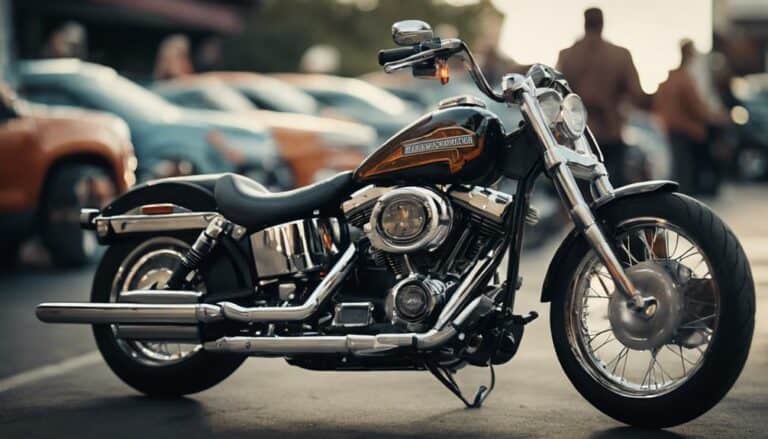Discover the dip in Harley-Davidson sales and the daunting challenges the iconic motorcycle company faces. Despite strategic efforts to revamp inventory levels and appeal to a younger demographic, the numbers paint a bleak picture.
What lies ahead for this legendary brand amidst shifting consumer habits and economic uncertainties? Stay tuned to uncover the intricate web of factors influencing Harley Davidson's sales performance and the strategies they might employ to navigate these turbulent waters.
Key Takeaways
- Revenue increased by 21% in Q1 2023.
- Global sales decreased by 7.2% in 2023.
- Customer preferences vary from latest to classic models.
- Online sales strategies focus on digital tools and customization.
Quarterly Sales Performance Analysis
In the first quarter of 2023, Harley-Davidson's sales performance exhibited a notable 21% increase in revenue compared to the previous year. This growth is particularly striking given the 12% decline in retail sales volume during the same period. Despite the drop in retail sales, motorcycle sales revenue managed to rise to $1.3 billion in Q1 2023. The company's total net income saw a substantial 37% increase to $304 million compared to the first quarter of 2022. Operating income for Harley-Davidson also surged impressively by 28% to $370 million in Q1 2023.
These financial achievements have positively impacted Harley-Davidson's earnings per share and operating income, showcasing a robust financial performance in the face of declining retail sales. The effective management of operating expenses and a focus on higher-margin products likely contributed to this solid performance. This data-driven analysis points towards the company's ability to navigate challenges and deliver strong results, demonstrating resilience and adaptability in a competitive market landscape.
Dealer Insights and Demographics
Harley-Davidson's dealer insights and demographics offer valuable perspectives on customer preferences and market dynamics, shedding light on the diverse range of riders and their purchasing behaviors. Dealerships attract a wide variety of customers, from seasoned riders looking for the latest models to newcomers eager to join the motorcycle community. These interactions with customers provide essential feedback on market trends, helping the company tailor its sales strategies to meet evolving demands. Demographics within Harley-Davidson dealerships span from young adventure-seeking riders to older enthusiasts in search of classic models, showcasing the brand's broad appeal across different age groups and interests.
| Customer Preferences | Market Dynamics | Purchasing Behaviors |
|---|---|---|
| Latest models and features | Emerging trends | Online vs. in-store buying |
| Classic designs and customization options | Competitor analysis | Financing preferences |
| Adventure and off-road capabilities | Customer feedback | Brand loyalty and repeat purchases |
Understanding these demographics and insights allows Harley-Davidson's Chief Executive to make informed decisions regarding retail sales strategies and product development, ensuring the brand continues to resonate with its diverse customer base.
Regional Sales Trends and Forecasts
Analyzing regional sales trends and forecasts reveals a consistent pattern of declining sales across all key markets for Harley-Davidson. In the second quarter of the fiscal year, the company faced challenges as sales figures continued to dip across various regions.
Some key points to consider are:
- Global Decline: Harley-Davidson experienced a 7.2% decrease in global sales in 2023, with all major regions showing a downward trend.
- Key Market Struggles: Markets like India, Japan, China, and South Korea witnessed notable declines, significantly impacting the overall sales performance.
- Historical Perspective: Over the past decade, Harley-Davidson's sales have halved, indicating a long-term struggle with intermittent periods of recovery and decline.
These insights suggest a concerning outlook for Harley-Davidson, emphasizing the need for strategic interventions to reverse the downward sales trajectory in the face of challenging market conditions.
Online Sales Strategies and Impact
With a notable shift towards digital marketing strategies, Harley-Davidson is strategically leveraging online platforms to enhance customer engagement and expand its market reach. The company's online sales strategy focuses on utilizing digital marketing tools to reach a broader customer base effectively. Harley-Davidson offers online customization tools that allow customers to personalize their bikes, creating a more immersive online buying experience. Additionally, customers can schedule test rides and explore financing options virtually through the online sales platform, enhancing convenience and accessibility. These online sales initiatives have not only helped Harley-Davidson adapt to changing consumer preferences but have also played a significant role in expanding the brand's reach beyond traditional brick-and-mortar dealerships.
| Online Sales Strategies | Impact |
|---|---|
| Digital marketing tools | Enhanced customer engagement |
| Online customization tools | Improved buying experience |
| Virtual test rides and financing options | Increased convenience |
| Adaptation to changing consumer preferences | Expanded market reach |
| Shift beyond brick-and-mortar dealerships | Broader customer base reach |
Customer Feedback and Satisfaction Surveys
Customer feedback surveys reveal a concerning trend of declining satisfaction with Harley-Davidson sales performance.
- Product Mix Changes: Customers express worries about how alterations in the product lineup are influencing their purchasing decisions.
- Model Discontinuations Impact: There's a noticeable shift in customer preferences towards models affected by production discontinuations.
- Customer Loyalty Challenges: Surveys show difficulties in maintaining customer loyalty amidst changes in Harley-Davidson's product offerings.
The data from these surveys and customer feedback highlight a critical need for Harley-Davidson to address concerns regarding product mix changes and their impact on customer satisfaction. Understanding the correlation between customer feedback and purchasing patterns is essential for Harley-Davidson to realign its sales strategy and regain customer trust.
As the market evolves, responding to customer preferences and ensuring a diverse product line will be pivotal in enhancing customer satisfaction and driving sales growth for Harley-Davidson.
Conclusion
Looking at Harley-Davidson's sales performance, it's clear that challenges lie ahead. Despite efforts to attract younger riders and manage inventory levels, the company is facing a tough road ahead.
Like a well-worn motorcycle navigating through rough terrain, Harley-Davidson must find new strategies to revitalize its sales and regain its position in the market. It's time to shift gears and accelerate towards a brighter future.

